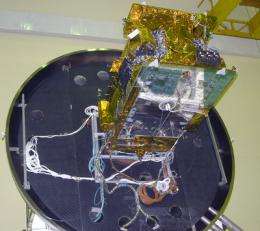Hylas satellite on schedule for launch

(PhysOrg.com) -- The completion of important tests on the Hylas telecommunications satellite has brought it a step closer to launch late this year. Once the final tests are completed, Hylas will be ready to be shipped to Europe's Spaceport in French Guiana in August.
In mid-May, thermal-vacuum testing was completed in Bangalore, India. The thermal-vacuum test is the most demanding phase of satellite testing. For Hylas, it involved taking the complete satellite between the temperature extremes it will experience in orbit several times over a period of four weeks. The test confirms the overall performance and build quality of the satellite subsystems.
Hylas, a public-private partnership between ESA and Avanti Communications (UK), will target the high demand for broadband services in Europe that cannot be met by terrestrial networks. It will provide capacity to serve hundreds of thousands of Internet users and broadcast up to 30 standard or 15 high-definition TV channels.
“The on-schedule completion of thermal vacuum testing is a significant milestone,” says Andrea Cotellessa, ESA’s Hylas Project Manager.
“In just four years from contract signature, we have completed the development and qualification of our advanced communication payload technologies.
“We have now demonstrated the full range of required performance in a simulated orbital environment - this enables us to move towards the launch campaign with great confidence.”
Astrium UK is the prime contractor leading the design and manufacture of Hylas and is responsible for developing the advanced Ku- and Ka-band payload. The Indian Space Research Organisation, in Bangalore, India, has provided the satellite platform. Other European and Canadian companies, including TESAT, ComDev and Casa Espacio, have supplied equipment for the communication payload.
ESA and Avanti signed the contract in 2006 for the development of Hylas, supporting the most innovative elements of this new system. The satellite is designed to have a lifetime of 15 years, and will be launched into a geostationary orbit at 33.5°W.
Provided by European Space Agency


















